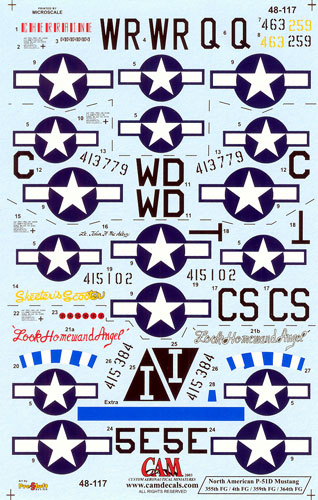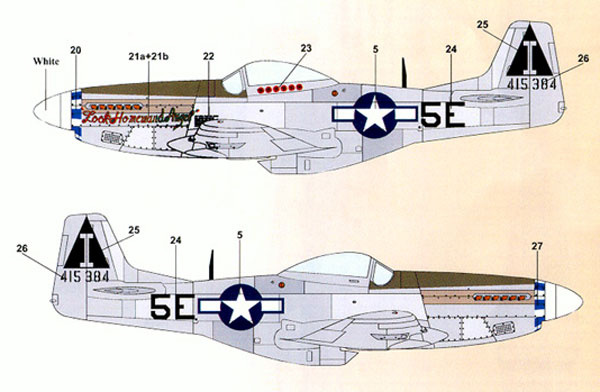S u m m a r y
|
| Catalogue
Number and Description: |
48-117 Thoroughbred Mustangs |
| Scale: |
1/48 |
| Contents and Media: |
Decal sheet; instruction
sheet with a colour cardboard header |
| Price: |
USD$10.00 |
| Review Type: |
FirstLook |
| Advantages: |
Impressive markings; sharply
printed; perfect register; minimum of decal film; three sets of
national markings supplied; complete markings for all options
(including national markings) |
| Disadvantages: |
|
| Recommendation: |
Recommended |
Reviewed by Rodger Kelly

HyperScale is proudly sponsored by
Squadron
Thoroughbred Mustangs 48-117 is Custom
Aeronautical Miniatures (Cam Decals) newest sheet in their series
covering the P-51D Mustang in 1/48 scale. The sheet provides markings
for four UK based 8th Air Force machines.
The first option is 44-63259, 'Cherraine'
flown LT Donald V. Galer
of the 354th Fighter Squadron, 355th
Fighter flying from Steeple Morden,
Cambridgeshire in 1944.
Like most of the European Theatre Mustangs, 'Cherraine'
is in overall natural metal finish with an olive drab anti-glare
panel. Her spinner is white and her nose and rudder are red.
 Markings
include: Markings
include:
-
A full set of national insignia.
-
Black WR squadron codes and individual
aircraft in squadron letter Q.
-
Black and yellow serial numbers for the
fin and rudder - the yellow is applied over the red of the rudder.
-
The name 'Cherraine' in red for
the left hand side of the nose.
-
A scoreboard of five German swastika
flags. This doesn’t look right to me as the Nazi flag was red and
not black. A study of available colour photographs of this squadron
show similar markings and they are red and not black.
-
A data block which displays the correct
serial number.
Next is 44-13779 an unnamed Mustang as flown by
Colonel Donald M. Blakeslee from Debden, Essex in 1945. The aircraft
was not named nor did it bear a scoreboard of any kind as Colonel
Blakeslee believed that it this sort of thing 'was for the kids'. The
machine is in natural metal finish with the 4th red nose
Group identification marking, a set of lower fuselage D-Day markings,
black theatre bands on the wings and horizontal stabilizers, as well
as the fin and rudder.
Markings include:
-
A full set of national insignia.
-
Black WD 336th Fighter
Squadron codes and individual aircraft in squadron letter C.
-
Black serial numbers for the fin and
rudder.
-
A data block which displays the correct
serial number.
Should you choose to model this option, be aware
that it lacks the fin strake.
The third option is 44-15102
'Skeeter’s Scooter' which was flown by Lt John F. McAlevy of
the 370th Fighter Squadron, 359th Fighter Group
whilst it was based at East Wretham, Norfolk in 1944.
The aircraft is in overall
natural metal finish and it bears green nose worn by all of the 359th
Fighter Group’s aircraft, and a blue rudder denoting that it was
an aircraft of the 370th Fighter Squadron. The aircraft
originally wore the black band theatre markings on its wings and
horizontal stabilizers but these had been removed leaving a lighter
shade of aluminium- no doubt as the result of the removal process.
The markings consist of:
·
The 370ths “CS” squadron codes with
the individual “T” aircraft code for the fuselage.
·
A set of national insignia.
·
The aircraft serial number for the
vertical stabilizer/rudder.
·
The 'Skeeter’s Scooter' name
for the nose (left side only).
·
The pilot’s name for the canopy
rail.
·
A data block that has the correct
serial number.
The final option is 'Look Homeward Angel'
44-15384 flown by Captain Capt. Arthur B McCormick of the 385th
Fighter Squadron, 364th Fighter Group out of Honington,
Sussex in 1944.
The aircraft is in overall natural metal finish
with an olive drab anti-glare panel. Her spinner is white and her nose
bears the 364th Fighter Group's identification markings of
blue and white stripes.
Markings include:
-
A full set of national insignia,
-
Black 5E squadron codes and individual
aircraft in squadron letter I in a Black triangle on the fin and
rudder. Black serial numbers for the fin and rudder.
-
The name Look Homeward Angel is
supplied as a two part decal of red over a black outline to address
any register problems that may arise.
-
A scoreboard of six German swastikas on
a red circle background. The blue and white Group markings are
supplied in three parts - left and right hand sides with a smaller
blue wedge-like piece for the intake. A further decal in the same
colour is provided in case you need to adjust these markings to fit
the kit of your choosing.
-
A data block which displays the correct
serial number.
The decal placement guide is the standard fare
from Cam Decals - an A-4 sized sheet with black and white profiles of
both sides of the fuselage and a plan view of the top surfaces of the
wings and the bottom surfaces of the wings for the first three
options. The front page shows full-colour left hand side profiles of
each aircraft whilst the rear page shows colour profiles of both sides
of the fuselage, a plan view of the top surfaces of the wings and
scrap views of the bottom surfaces of the wings for 'Look Homeward
Angel'.
The decals have been printed by Microscale and
are well up to their high standards. They are all sharply printed and
in perfect register.
The placement guide, decal sheet and header card
come packed in a clear plastic zip-loc bag.

The recommended kits are the Tamiya and Hasegawa
ones.
This really is a good sheet from Cam Decals.
Complete marking are provided for each option. The only thing
missing is the stencil data but to be truthful, there really isn't any
spare room to fit it into.
Recommended.
Thanks to
Brookhurst Hobbies for the review sample.
CAM Decals are available online
from their website at http://www.camdecals.com
and from
Brookhurst Hobbies
CAM Decals 59 page 2002 color
catalog of decals and resin parts is also
now available through the CAM Decals website
Review Copyright © 2004 by
Rodger Kelly
This Page Created on 21 January, 2004
Last updated
20 January, 2004
Back to
HyperScale Main Page Back to Reviews Page |
Home | What's
New | Features
| Gallery |
Reviews | Reference
| Forum
| Search